Data Analysis Techniques Report: Manchester Wind Speed Forecasting
VerifiedAdded on 2021/02/19
|11
|1889
|33
Report
AI Summary
This report presents an analysis of wind speed data from Manchester, England, employing various data analysis techniques. The report begins with data representation in tabular and graphical formats, including bar and column charts. It then proceeds to calculate key statistical measures such as mean, median, mode, standard deviation, and range. Furthermore, the report utilizes a linear forecasting model to predict wind speeds for days 14 and 21. The methodology involves calculating 'm' and 'c' values from the regression equation (y = mx + c) to forecast future wind speeds. The findings demonstrate the application of these techniques to extract meaningful insights from the wind speed data, concluding with forecasted values for the specified days. The report includes tables, calculations, and a conclusion summarizing the analysis and findings, supported by relevant references.
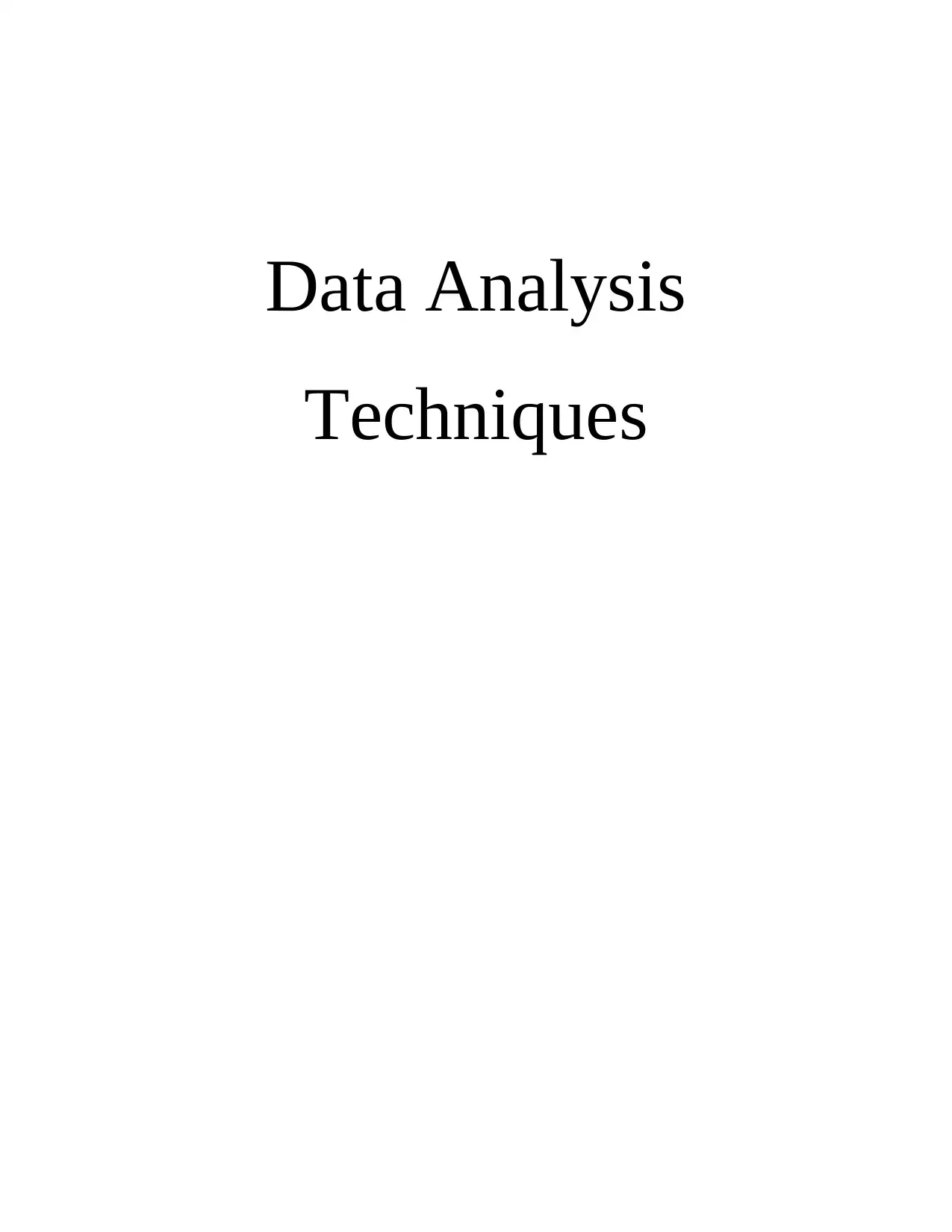
Data Analysis
Techniques
Techniques
Paraphrase This Document
Need a fresh take? Get an instant paraphrase of this document with our AI Paraphraser
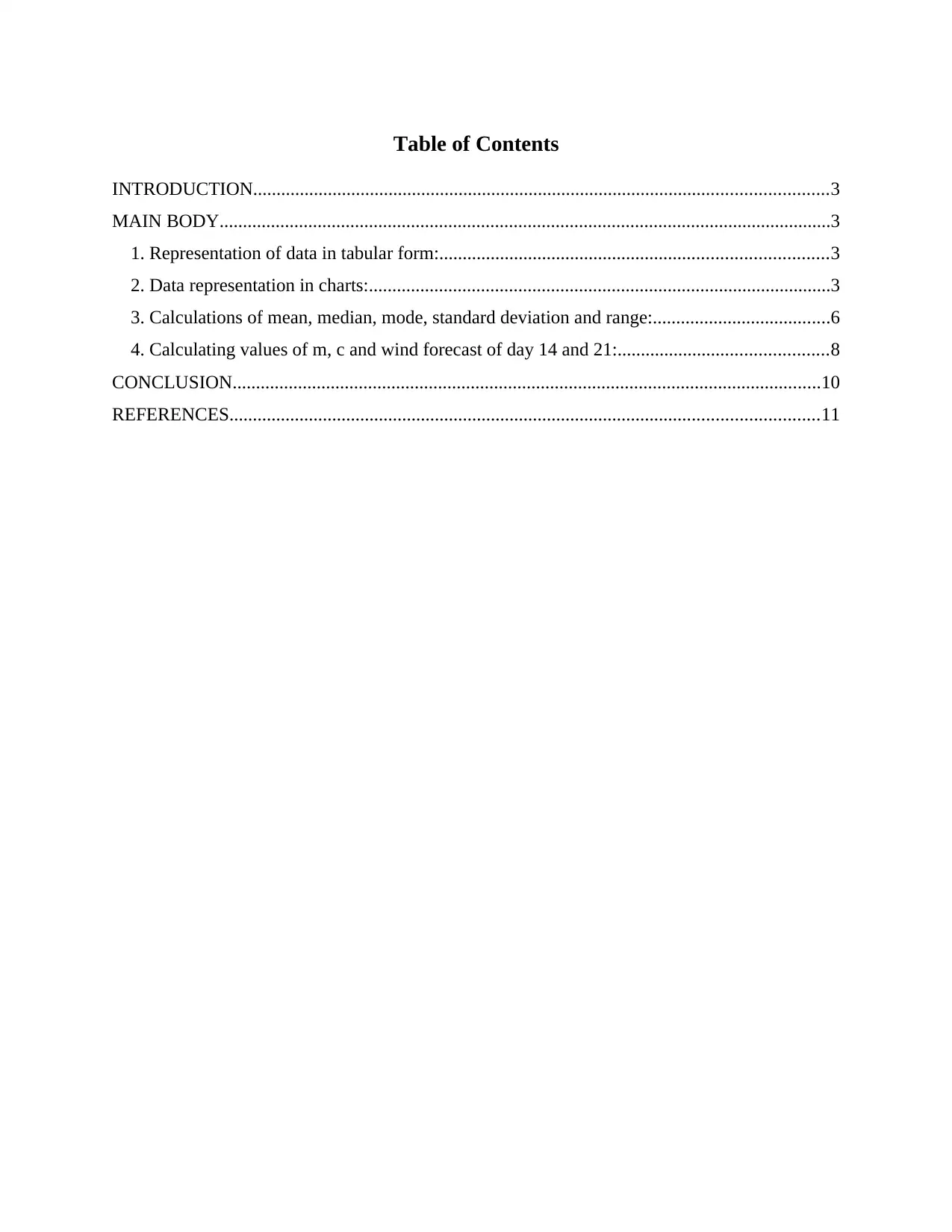
Table of Contents
INTRODUCTION...........................................................................................................................3
MAIN BODY...................................................................................................................................3
1. Representation of data in tabular form:...................................................................................3
2. Data representation in charts:...................................................................................................3
3. Calculations of mean, median, mode, standard deviation and range:......................................6
4. Calculating values of m, c and wind forecast of day 14 and 21:.............................................8
CONCLUSION..............................................................................................................................10
REFERENCES..............................................................................................................................11
INTRODUCTION...........................................................................................................................3
MAIN BODY...................................................................................................................................3
1. Representation of data in tabular form:...................................................................................3
2. Data representation in charts:...................................................................................................3
3. Calculations of mean, median, mode, standard deviation and range:......................................6
4. Calculating values of m, c and wind forecast of day 14 and 21:.............................................8
CONCLUSION..............................................................................................................................10
REFERENCES..............................................................................................................................11
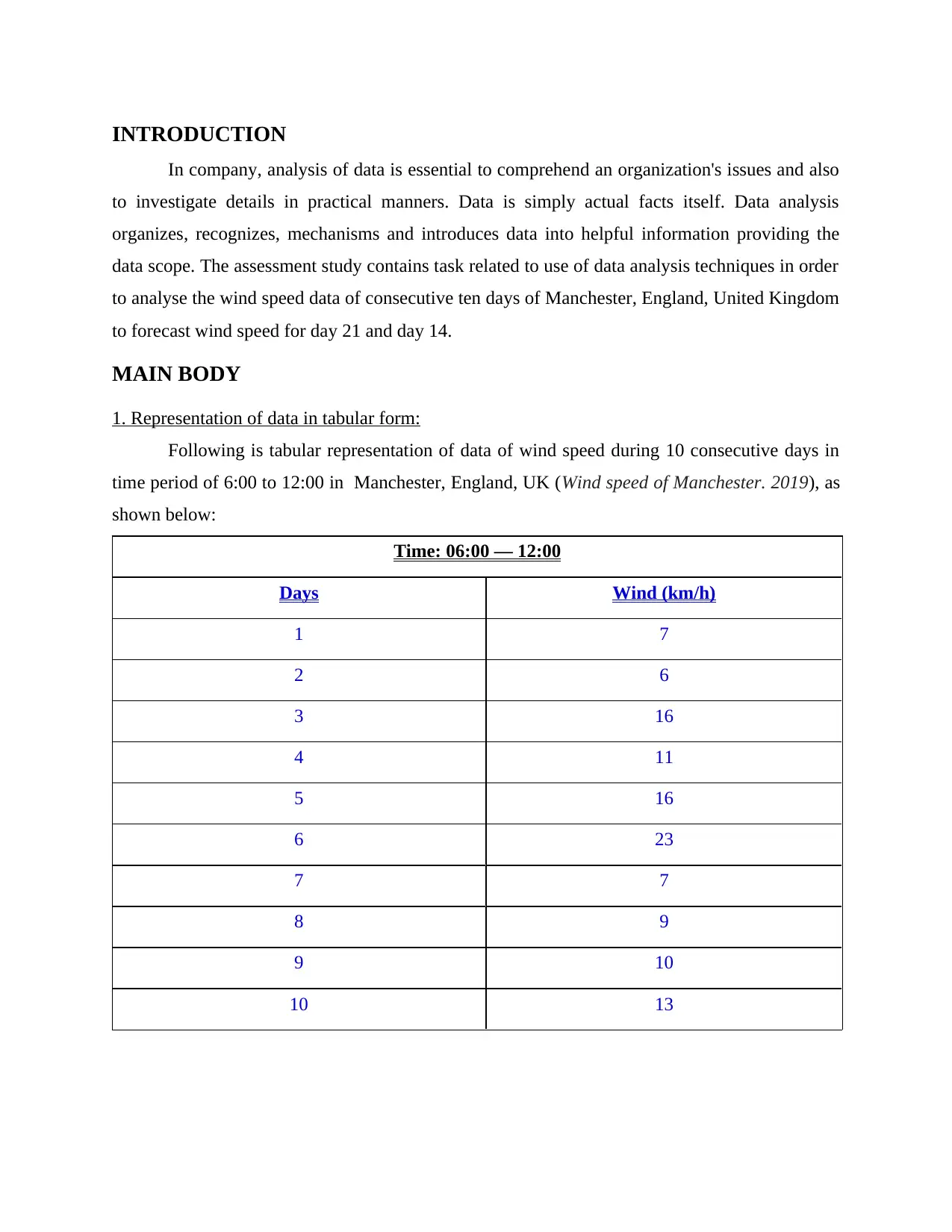
INTRODUCTION
In company, analysis of data is essential to comprehend an organization's issues and also
to investigate details in practical manners. Data is simply actual facts itself. Data analysis
organizes, recognizes, mechanisms and introduces data into helpful information providing the
data scope. The assessment study contains task related to use of data analysis techniques in order
to analyse the wind speed data of consecutive ten days of Manchester, England, United Kingdom
to forecast wind speed for day 21 and day 14.
MAIN BODY
1. Representation of data in tabular form:
Following is tabular representation of data of wind speed during 10 consecutive days in
time period of 6:00 to 12:00 in Manchester, England, UK (Wind speed of Manchester. 2019), as
shown below:
Time: 06:00 — 12:00
Days Wind (km/h)
1 7
2 6
3 16
4 11
5 16
6 23
7 7
8 9
9 10
10 13
In company, analysis of data is essential to comprehend an organization's issues and also
to investigate details in practical manners. Data is simply actual facts itself. Data analysis
organizes, recognizes, mechanisms and introduces data into helpful information providing the
data scope. The assessment study contains task related to use of data analysis techniques in order
to analyse the wind speed data of consecutive ten days of Manchester, England, United Kingdom
to forecast wind speed for day 21 and day 14.
MAIN BODY
1. Representation of data in tabular form:
Following is tabular representation of data of wind speed during 10 consecutive days in
time period of 6:00 to 12:00 in Manchester, England, UK (Wind speed of Manchester. 2019), as
shown below:
Time: 06:00 — 12:00
Days Wind (km/h)
1 7
2 6
3 16
4 11
5 16
6 23
7 7
8 9
9 10
10 13
⊘ This is a preview!⊘
Do you want full access?
Subscribe today to unlock all pages.

Trusted by 1+ million students worldwide
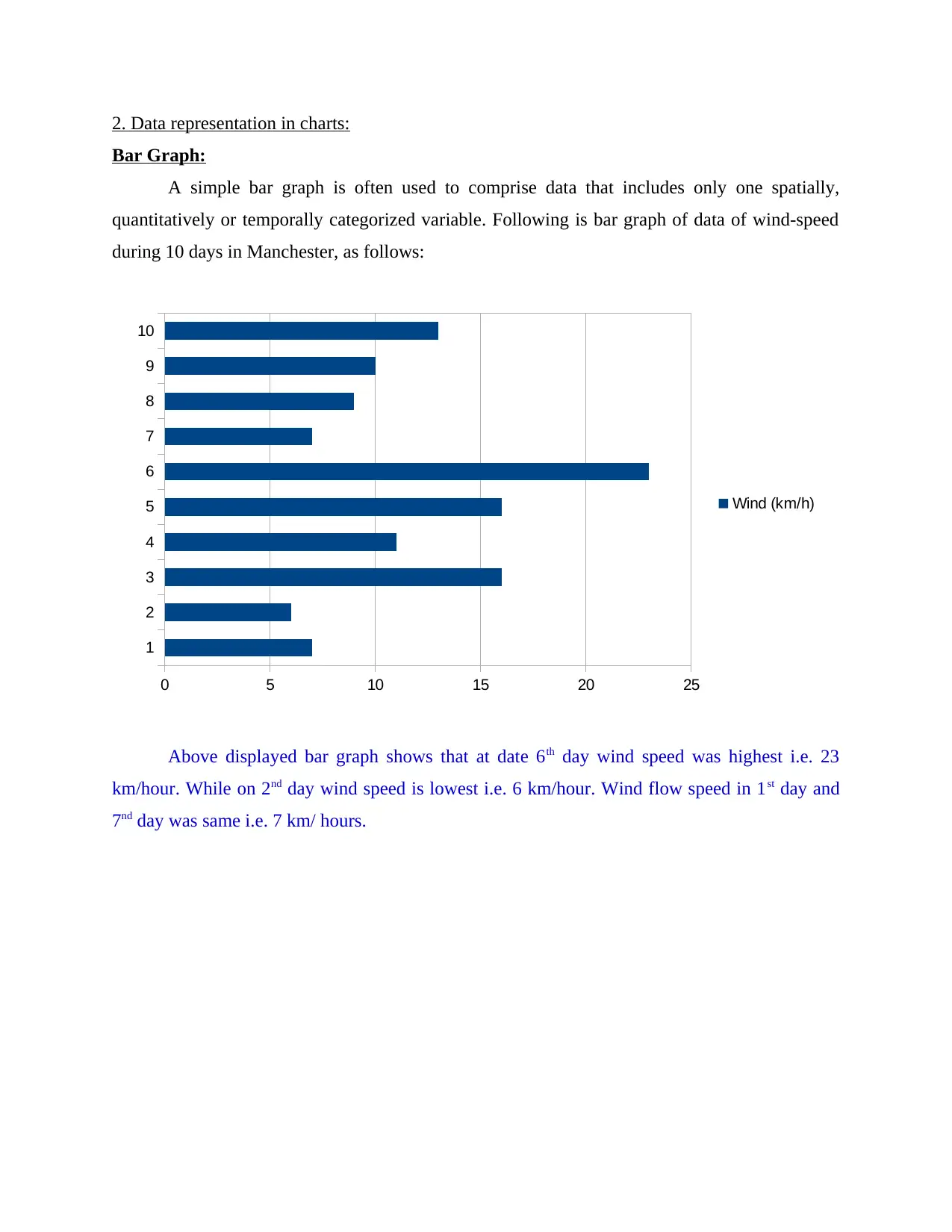
2. Data representation in charts:
Bar Graph:
A simple bar graph is often used to comprise data that includes only one spatially,
quantitatively or temporally categorized variable. Following is bar graph of data of wind-speed
during 10 days in Manchester, as follows:
Above displayed bar graph shows that at date 6th day wind speed was highest i.e. 23
km/hour. While on 2nd day wind speed is lowest i.e. 6 km/hour. Wind flow speed in 1st day and
7nd day was same i.e. 7 km/ hours.
1
2
3
4
5
6
7
8
9
10
0 5 10 15 20 25
Wind (km/h)
Bar Graph:
A simple bar graph is often used to comprise data that includes only one spatially,
quantitatively or temporally categorized variable. Following is bar graph of data of wind-speed
during 10 days in Manchester, as follows:
Above displayed bar graph shows that at date 6th day wind speed was highest i.e. 23
km/hour. While on 2nd day wind speed is lowest i.e. 6 km/hour. Wind flow speed in 1st day and
7nd day was same i.e. 7 km/ hours.
1
2
3
4
5
6
7
8
9
10
0 5 10 15 20 25
Wind (km/h)
Paraphrase This Document
Need a fresh take? Get an instant paraphrase of this document with our AI Paraphraser
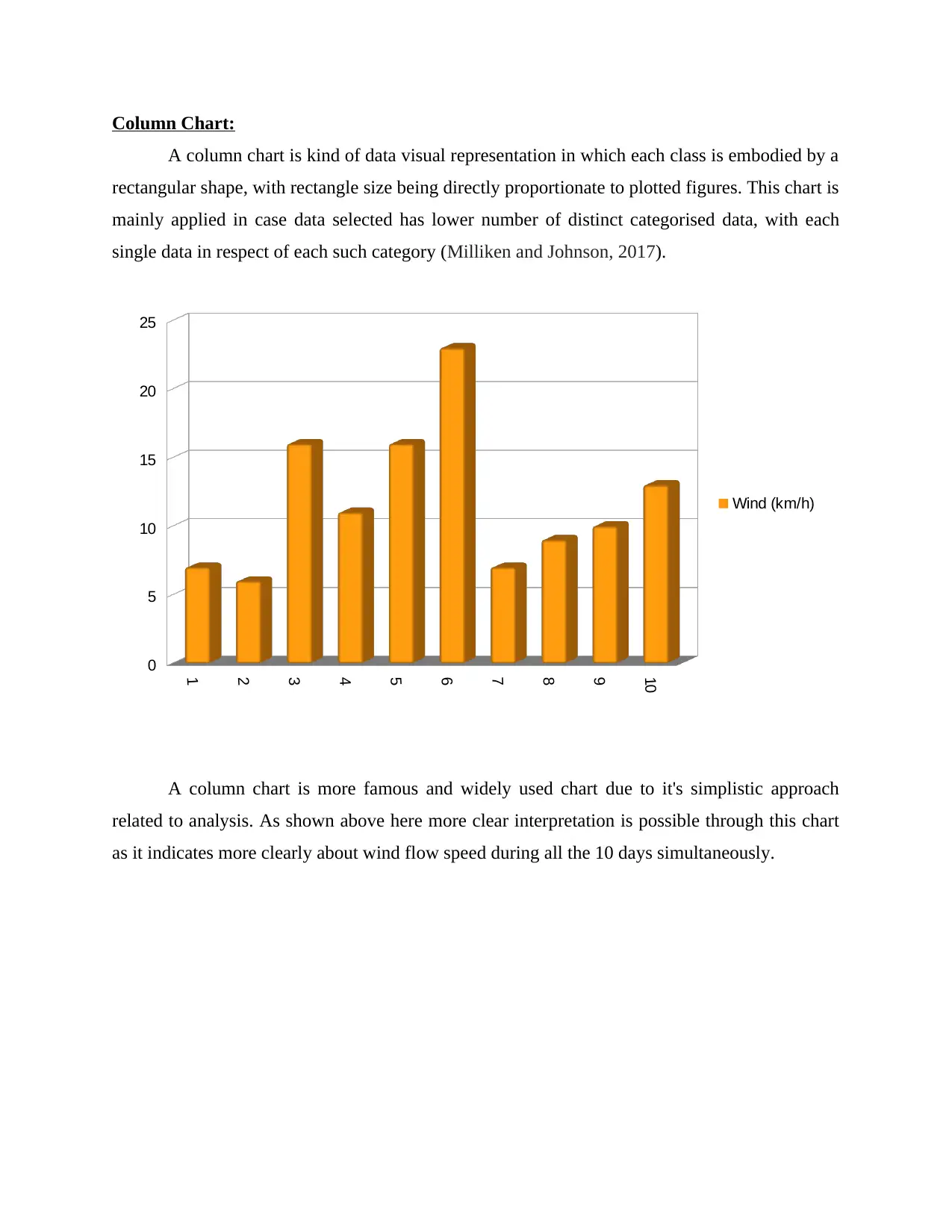
Column Chart:
A column chart is kind of data visual representation in which each class is embodied by a
rectangular shape, with rectangle size being directly proportionate to plotted figures. This chart is
mainly applied in case data selected has lower number of distinct categorised data, with each
single data in respect of each such category (Milliken and Johnson, 2017).
A column chart is more famous and widely used chart due to it's simplistic approach
related to analysis. As shown above here more clear interpretation is possible through this chart
as it indicates more clearly about wind flow speed during all the 10 days simultaneously.
1
2
3
4
5
6
7
8
9
10
0
5
10
15
20
25
Wind (km/h)
A column chart is kind of data visual representation in which each class is embodied by a
rectangular shape, with rectangle size being directly proportionate to plotted figures. This chart is
mainly applied in case data selected has lower number of distinct categorised data, with each
single data in respect of each such category (Milliken and Johnson, 2017).
A column chart is more famous and widely used chart due to it's simplistic approach
related to analysis. As shown above here more clear interpretation is possible through this chart
as it indicates more clearly about wind flow speed during all the 10 days simultaneously.
1
2
3
4
5
6
7
8
9
10
0
5
10
15
20
25
Wind (km/h)
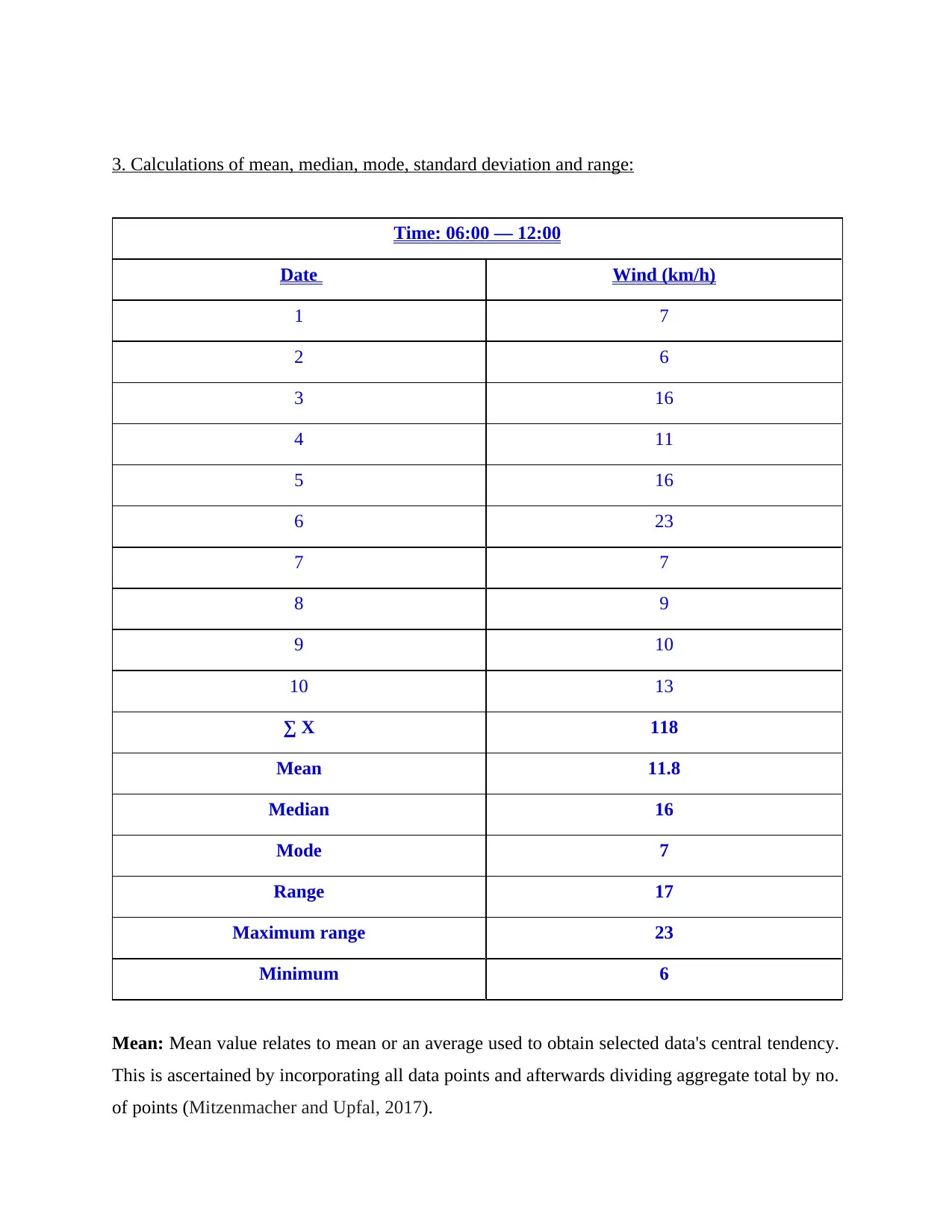
3. Calculations of mean, median, mode, standard deviation and range:
Time: 06:00 — 12:00
Date Wind (km/h)
1 7
2 6
3 16
4 11
5 16
6 23
7 7
8 9
9 10
10 13
∑ X 118
Mean 11.8
Median 16
Mode 7
Range 17
Maximum range 23
Minimum 6
Mean: Mean value relates to mean or an average used to obtain selected data's central tendency.
This is ascertained by incorporating all data points and afterwards dividing aggregate total by no.
of points (Mitzenmacher and Upfal, 2017).
Time: 06:00 — 12:00
Date Wind (km/h)
1 7
2 6
3 16
4 11
5 16
6 23
7 7
8 9
9 10
10 13
∑ X 118
Mean 11.8
Median 16
Mode 7
Range 17
Maximum range 23
Minimum 6
Mean: Mean value relates to mean or an average used to obtain selected data's central tendency.
This is ascertained by incorporating all data points and afterwards dividing aggregate total by no.
of points (Mitzenmacher and Upfal, 2017).
⊘ This is a preview!⊘
Do you want full access?
Subscribe today to unlock all pages.

Trusted by 1+ million students worldwide
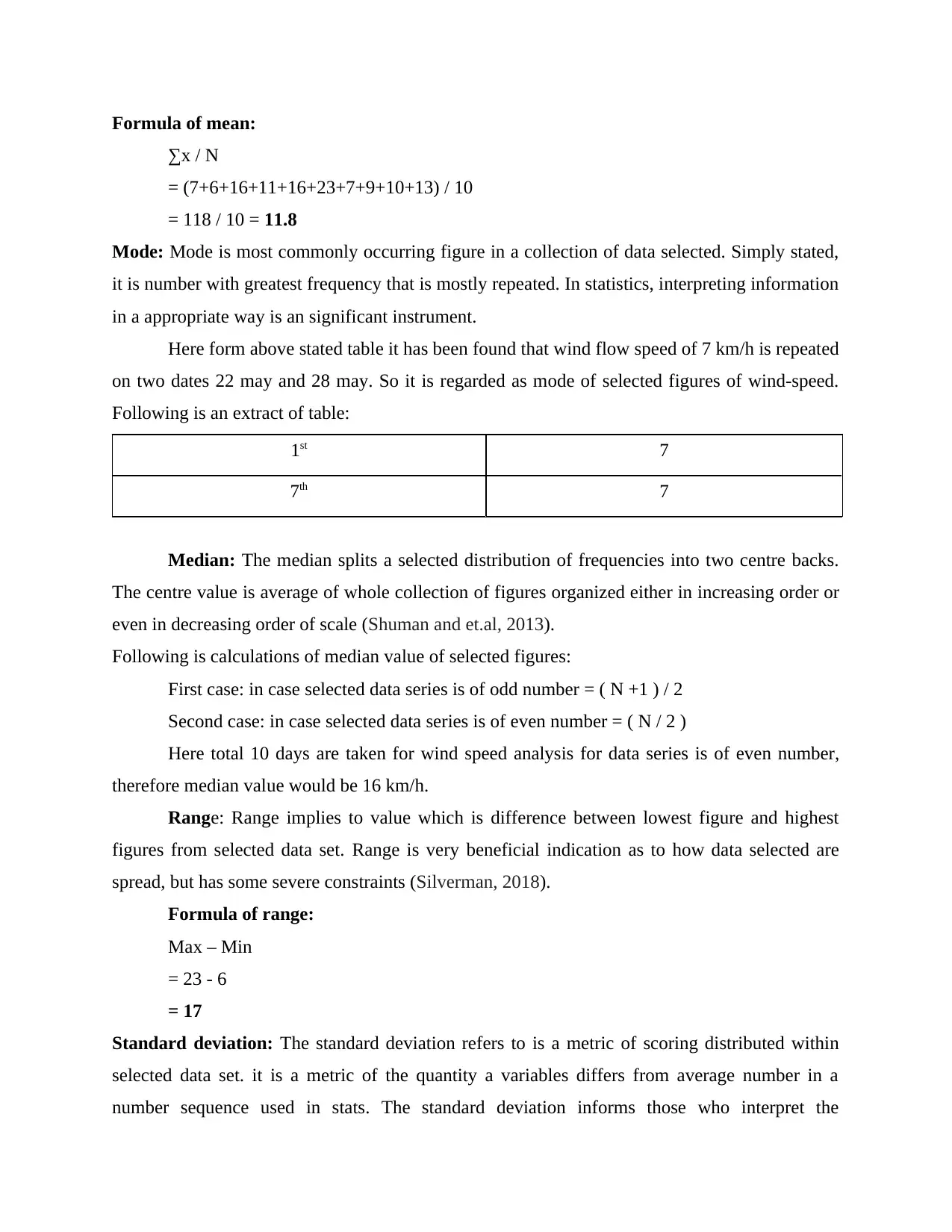
Formula of mean:
∑x / N
= (7+6+16+11+16+23+7+9+10+13) / 10
= 118 / 10 = 11.8
Mode: Mode is most commonly occurring figure in a collection of data selected. Simply stated,
it is number with greatest frequency that is mostly repeated. In statistics, interpreting information
in a appropriate way is an significant instrument.
Here form above stated table it has been found that wind flow speed of 7 km/h is repeated
on two dates 22 may and 28 may. So it is regarded as mode of selected figures of wind-speed.
Following is an extract of table:
1st 7
7th 7
Median: The median splits a selected distribution of frequencies into two centre backs.
The centre value is average of whole collection of figures organized either in increasing order or
even in decreasing order of scale (Shuman and et.al, 2013).
Following is calculations of median value of selected figures:
First case: in case selected data series is of odd number = ( N +1 ) / 2
Second case: in case selected data series is of even number = ( N / 2 )
Here total 10 days are taken for wind speed analysis for data series is of even number,
therefore median value would be 16 km/h.
Range: Range implies to value which is difference between lowest figure and highest
figures from selected data set. Range is very beneficial indication as to how data selected are
spread, but has some severe constraints (Silverman, 2018).
Formula of range:
Max – Min
= 23 - 6
= 17
Standard deviation: The standard deviation refers to is a metric of scoring distributed within
selected data set. it is a metric of the quantity a variables differs from average number in a
number sequence used in stats. The standard deviation informs those who interpret the
∑x / N
= (7+6+16+11+16+23+7+9+10+13) / 10
= 118 / 10 = 11.8
Mode: Mode is most commonly occurring figure in a collection of data selected. Simply stated,
it is number with greatest frequency that is mostly repeated. In statistics, interpreting information
in a appropriate way is an significant instrument.
Here form above stated table it has been found that wind flow speed of 7 km/h is repeated
on two dates 22 may and 28 may. So it is regarded as mode of selected figures of wind-speed.
Following is an extract of table:
1st 7
7th 7
Median: The median splits a selected distribution of frequencies into two centre backs.
The centre value is average of whole collection of figures organized either in increasing order or
even in decreasing order of scale (Shuman and et.al, 2013).
Following is calculations of median value of selected figures:
First case: in case selected data series is of odd number = ( N +1 ) / 2
Second case: in case selected data series is of even number = ( N / 2 )
Here total 10 days are taken for wind speed analysis for data series is of even number,
therefore median value would be 16 km/h.
Range: Range implies to value which is difference between lowest figure and highest
figures from selected data set. Range is very beneficial indication as to how data selected are
spread, but has some severe constraints (Silverman, 2018).
Formula of range:
Max – Min
= 23 - 6
= 17
Standard deviation: The standard deviation refers to is a metric of scoring distributed within
selected data set. it is a metric of the quantity a variables differs from average number in a
number sequence used in stats. The standard deviation informs those who interpret the
Paraphrase This Document
Need a fresh take? Get an instant paraphrase of this document with our AI Paraphraser
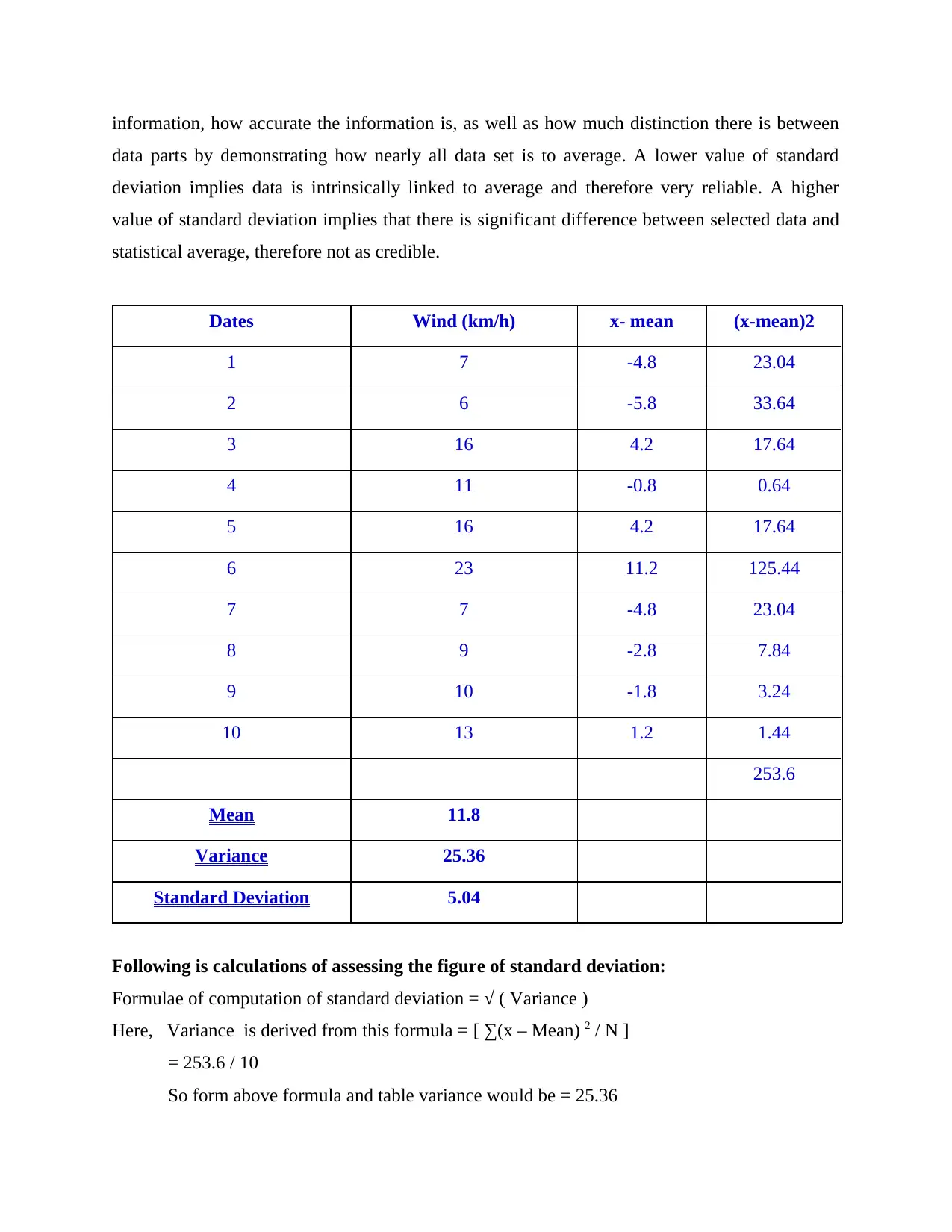
information, how accurate the information is, as well as how much distinction there is between
data parts by demonstrating how nearly all data set is to average. A lower value of standard
deviation implies data is intrinsically linked to average and therefore very reliable. A higher
value of standard deviation implies that there is significant difference between selected data and
statistical average, therefore not as credible.
Dates Wind (km/h) x- mean (x-mean)2
1 7 -4.8 23.04
2 6 -5.8 33.64
3 16 4.2 17.64
4 11 -0.8 0.64
5 16 4.2 17.64
6 23 11.2 125.44
7 7 -4.8 23.04
8 9 -2.8 7.84
9 10 -1.8 3.24
10 13 1.2 1.44
253.6
Mean 11.8
Variance 25.36
Standard Deviation 5.04
Following is calculations of assessing the figure of standard deviation:
Formulae of computation of standard deviation = √ ( Variance )
Here, Variance is derived from this formula = [ ∑(x – Mean) 2 / N ]
= 253.6 / 10
So form above formula and table variance would be = 25.36
data parts by demonstrating how nearly all data set is to average. A lower value of standard
deviation implies data is intrinsically linked to average and therefore very reliable. A higher
value of standard deviation implies that there is significant difference between selected data and
statistical average, therefore not as credible.
Dates Wind (km/h) x- mean (x-mean)2
1 7 -4.8 23.04
2 6 -5.8 33.64
3 16 4.2 17.64
4 11 -0.8 0.64
5 16 4.2 17.64
6 23 11.2 125.44
7 7 -4.8 23.04
8 9 -2.8 7.84
9 10 -1.8 3.24
10 13 1.2 1.44
253.6
Mean 11.8
Variance 25.36
Standard Deviation 5.04
Following is calculations of assessing the figure of standard deviation:
Formulae of computation of standard deviation = √ ( Variance )
Here, Variance is derived from this formula = [ ∑(x – Mean) 2 / N ]
= 253.6 / 10
So form above formula and table variance would be = 25.36
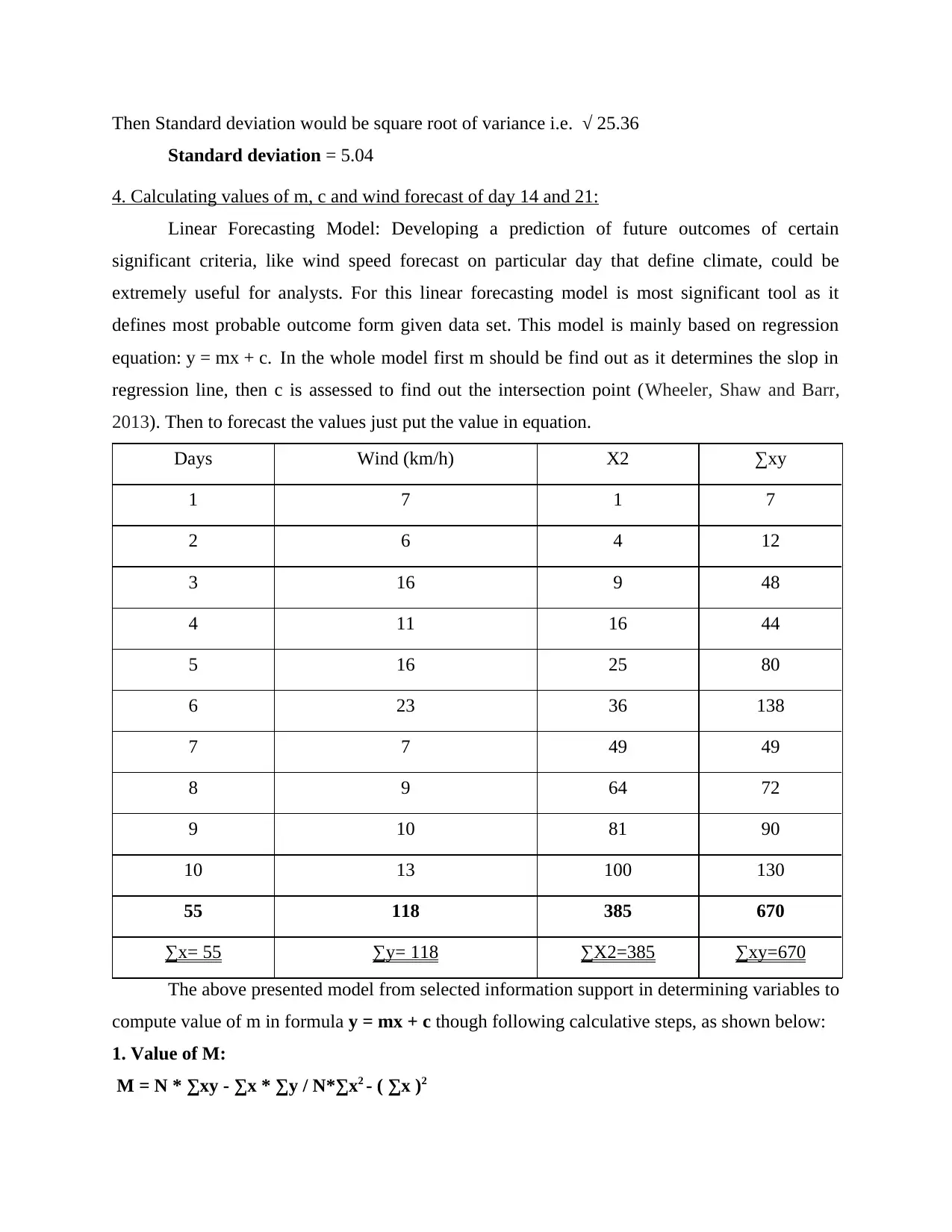
Then Standard deviation would be square root of variance i.e. √ 25.36
Standard deviation = 5.04
4. Calculating values of m, c and wind forecast of day 14 and 21:
Linear Forecasting Model: Developing a prediction of future outcomes of certain
significant criteria, like wind speed forecast on particular day that define climate, could be
extremely useful for analysts. For this linear forecasting model is most significant tool as it
defines most probable outcome form given data set. This model is mainly based on regression
equation: y = mx + c. In the whole model first m should be find out as it determines the slop in
regression line, then c is assessed to find out the intersection point (Wheeler, Shaw and Barr,
2013). Then to forecast the values just put the value in equation.
Days Wind (km/h) X2 ∑xy
1 7 1 7
2 6 4 12
3 16 9 48
4 11 16 44
5 16 25 80
6 23 36 138
7 7 49 49
8 9 64 72
9 10 81 90
10 13 100 130
55 118 385 670
∑x= 55 ∑y= 118 ∑X2=385 ∑xy=670
The above presented model from selected information support in determining variables to
compute value of m in formula y = mx + c though following calculative steps, as shown below:
1. Value of M:
M = N * ∑xy - ∑x * ∑y / N*∑x2 - ( ∑x )2
Standard deviation = 5.04
4. Calculating values of m, c and wind forecast of day 14 and 21:
Linear Forecasting Model: Developing a prediction of future outcomes of certain
significant criteria, like wind speed forecast on particular day that define climate, could be
extremely useful for analysts. For this linear forecasting model is most significant tool as it
defines most probable outcome form given data set. This model is mainly based on regression
equation: y = mx + c. In the whole model first m should be find out as it determines the slop in
regression line, then c is assessed to find out the intersection point (Wheeler, Shaw and Barr,
2013). Then to forecast the values just put the value in equation.
Days Wind (km/h) X2 ∑xy
1 7 1 7
2 6 4 12
3 16 9 48
4 11 16 44
5 16 25 80
6 23 36 138
7 7 49 49
8 9 64 72
9 10 81 90
10 13 100 130
55 118 385 670
∑x= 55 ∑y= 118 ∑X2=385 ∑xy=670
The above presented model from selected information support in determining variables to
compute value of m in formula y = mx + c though following calculative steps, as shown below:
1. Value of M:
M = N * ∑xy - ∑x * ∑y / N*∑x2 - ( ∑x )2
⊘ This is a preview!⊘
Do you want full access?
Subscribe today to unlock all pages.

Trusted by 1+ million students worldwide
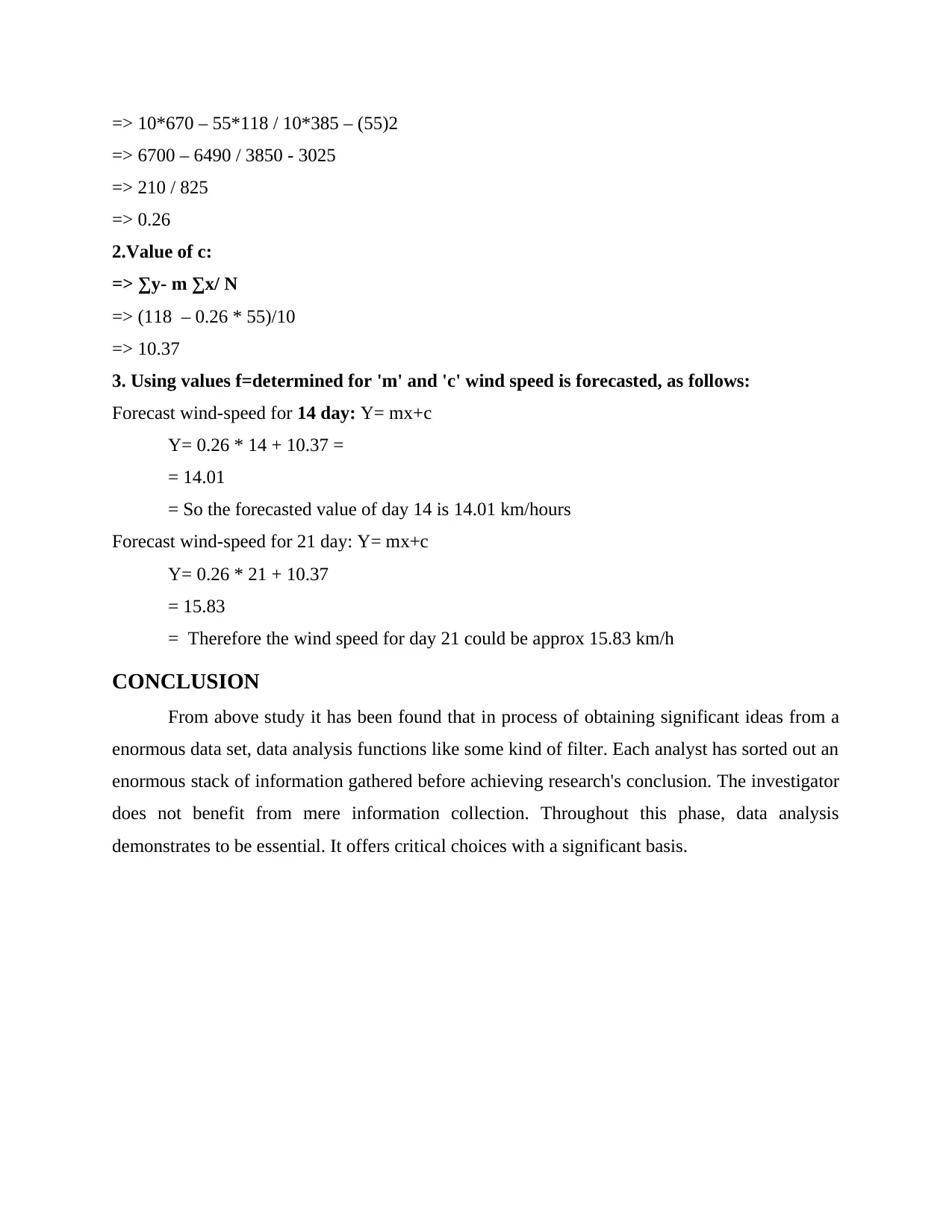
=> 10*670 – 55*118 / 10*385 – (55)2
=> 6700 – 6490 / 3850 - 3025
=> 210 / 825
=> 0.26
2.Value of c:
=> ∑y- m ∑x/ N
=> (118 – 0.26 * 55)/10
=> 10.37
3. Using values f=determined for 'm' and 'c' wind speed is forecasted, as follows:
Forecast wind-speed for 14 day: Y= mx+c
Y= 0.26 * 14 + 10.37 =
= 14.01
= So the forecasted value of day 14 is 14.01 km/hours
Forecast wind-speed for 21 day: Y= mx+c
Y= 0.26 * 21 + 10.37
= 15.83
= Therefore the wind speed for day 21 could be approx 15.83 km/h
CONCLUSION
From above study it has been found that in process of obtaining significant ideas from a
enormous data set, data analysis functions like some kind of filter. Each analyst has sorted out an
enormous stack of information gathered before achieving research's conclusion. The investigator
does not benefit from mere information collection. Throughout this phase, data analysis
demonstrates to be essential. It offers critical choices with a significant basis.
=> 6700 – 6490 / 3850 - 3025
=> 210 / 825
=> 0.26
2.Value of c:
=> ∑y- m ∑x/ N
=> (118 – 0.26 * 55)/10
=> 10.37
3. Using values f=determined for 'm' and 'c' wind speed is forecasted, as follows:
Forecast wind-speed for 14 day: Y= mx+c
Y= 0.26 * 14 + 10.37 =
= 14.01
= So the forecasted value of day 14 is 14.01 km/hours
Forecast wind-speed for 21 day: Y= mx+c
Y= 0.26 * 21 + 10.37
= 15.83
= Therefore the wind speed for day 21 could be approx 15.83 km/h
CONCLUSION
From above study it has been found that in process of obtaining significant ideas from a
enormous data set, data analysis functions like some kind of filter. Each analyst has sorted out an
enormous stack of information gathered before achieving research's conclusion. The investigator
does not benefit from mere information collection. Throughout this phase, data analysis
demonstrates to be essential. It offers critical choices with a significant basis.
Paraphrase This Document
Need a fresh take? Get an instant paraphrase of this document with our AI Paraphraser

REFERENCES
Books and Journals:
Anderberg, M.R., 2014. Cluster analysis for applications: probability and mathematical
statistics: a series of monographs and textbooks (Vol. 19). Academic press.
Hox, J.J., Moerbeek, M. and Van de Schoot, R., 2017. Multilevel analysis: Techniques and
applications. Routledge.
Jobson, J.D., 2012. Applied multivariate data analysis: volume II: Categorical and Multivariate
Methods. Springer Science & Business Media.
Milliken, G.A. and Johnson, D.E., 2017. Analysis of messy data, volume II: Nonreplicated
experiments. Chapman and Hall/CRC.
Mitzenmacher, M. and Upfal, E., 2017. Probability and computing: randomization and
probabilistic techniques in algorithms and data analysis. Cambridge university press.
Shuman, D.I., and et.al, 2013. The emerging field of signal processing on graphs: Extending
high-dimensional data analysis to networks and other irregular domains. IEEE signal
processing magazine. 30(3). pp. 83-98.
Silverman, B.W., 2018. Density estimation for statistics and data analysis. Routledge.
Wheeler, D., Shaw, G. and Barr, S., 2013. Statistical techniques in geographical analysis.
Routledge.
Online:
Wind speed of Manchester. 2019. [Online]. Available through:
<https://www.timeanddate.com/weather/uk/manchester/historic?month=5&year=2019>
Books and Journals:
Anderberg, M.R., 2014. Cluster analysis for applications: probability and mathematical
statistics: a series of monographs and textbooks (Vol. 19). Academic press.
Hox, J.J., Moerbeek, M. and Van de Schoot, R., 2017. Multilevel analysis: Techniques and
applications. Routledge.
Jobson, J.D., 2012. Applied multivariate data analysis: volume II: Categorical and Multivariate
Methods. Springer Science & Business Media.
Milliken, G.A. and Johnson, D.E., 2017. Analysis of messy data, volume II: Nonreplicated
experiments. Chapman and Hall/CRC.
Mitzenmacher, M. and Upfal, E., 2017. Probability and computing: randomization and
probabilistic techniques in algorithms and data analysis. Cambridge university press.
Shuman, D.I., and et.al, 2013. The emerging field of signal processing on graphs: Extending
high-dimensional data analysis to networks and other irregular domains. IEEE signal
processing magazine. 30(3). pp. 83-98.
Silverman, B.W., 2018. Density estimation for statistics and data analysis. Routledge.
Wheeler, D., Shaw, G. and Barr, S., 2013. Statistical techniques in geographical analysis.
Routledge.
Online:
Wind speed of Manchester. 2019. [Online]. Available through:
<https://www.timeanddate.com/weather/uk/manchester/historic?month=5&year=2019>
1 out of 11